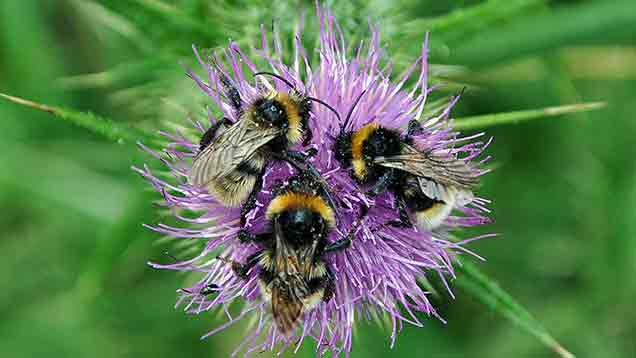Hedges, flower-rich margins and woodland feed bees’ needs
 © Peter Thompson
© Peter Thompson Farmers and land managers need to devote more land to flower-rich habitats to help save bees and other pollinating insects, new research has found.
The five-year study, which formed part of the *Farm4Bio project, suggested that at least a 7% increase in flower-rich margins on arable land was needed to double pollinator numbers.
Entomologists from the Game and Wildlife Conservation Trust (GWCT) and Rothamsted Research carried out the study in two English regions – Devon and Cornwall and East Anglia.
See also: Protect pollinators – the next ‘big ask’ on farms
The research concluded that the success of current agri-environment scheme habitats for pollinators was “variable” and “depends on their type and quality”.
At present, the uptake of flower-rich habitats in agri-environment schemes was “low nationally”, the study found – and farmers needed encouragement to try these options.
Dr John Holland, GWCT head of farmland ecology, said: “Our study confirmed the lack of flower-rich habitat was a limiting factor in the recovery of wild bees, butterflies and other pollinators.
“It also showed we need to balance the creation of new flower-rich habitats to ensure this does not detract pollinating insects away from existing natural wild plants and crops that also need to attract pollinators.”
The study, published in the science journal Biological Conservation and called “Managing habitats on English farmland for insect pollinator conservation” identified other ways in which farmland landscapes could be improved for pollinators, which would reduce the need to take more land out of production:
- Protect hedges and woodland edges from fertiliser and herbicide drift
- Woodland edges are invaluable habitats for bees and butterflies and they need managing to increase pollinators
- Create a diverse structure in woodland by coppicing and opening “rides” that help encourage the growth of flowers and shrubby layers.
Dr Holland added: “When pollinators such as queen bumblebees come out of hibernation in early spring, they need an ample supply of nectar from spring flowers, such as white deadnettle, primrose and bluebells, so they can start a breeding colony.
“Woodland can therefore be a particularly important habitat for pollinators in the landscape during early spring.”
See also: Video – woodland ‘back on management radar’
Defra secretary Liz Truss launched a 10-year national pollinator strategy to safeguard and promote bee and insect populations, seen as vital to agriculture, in November.
The voluntary stewardship scheme, the Campaign for the Farmed Environment (CFE) is also encouraging arable farmers to devote at least 1% of their land to flower-rich margins.
* The Farm4Bio project was funded by the Sustainable Arable LINK programme supported by Defra, BASF, Bayer CropScience, PGRO, Syngenta and The Arable Group.
* Find out more about Countryside Stewardship grants for flower-rich margins and plots

